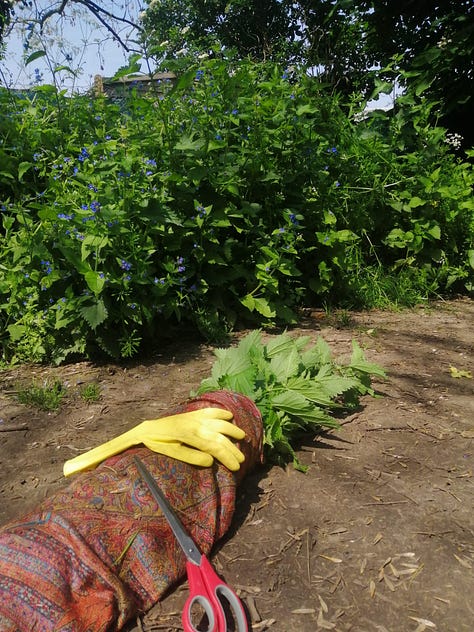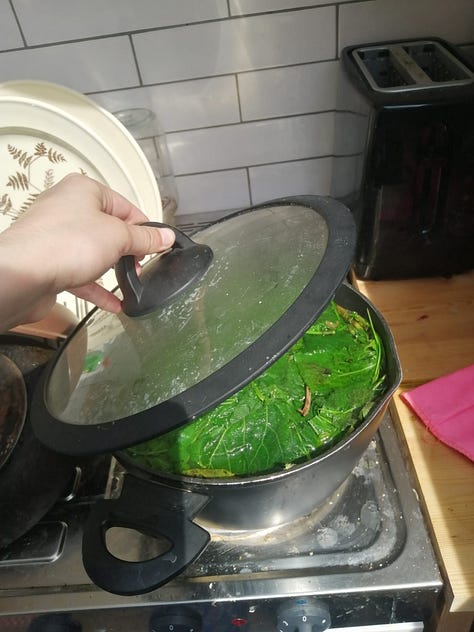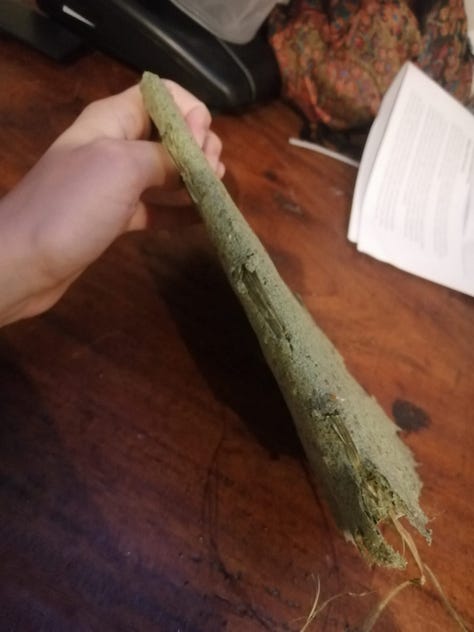Unstitching and Reconverging the Audiovisual
Threading Lines of Entangled Media through Malleable Space and Time
Ever Outward, Never Forward is a practise research project that explores the possibility of unstitching audiovisual media from its linear timeline in order to explore layered malleable time and the interaction of these layers. I was led by the questions:
How I can express a feeling of malleable time outside clock time through converging mediums?
How can I engage with the rhythms of nature to help express this?
The piece mediates sunlight sonically and visually, with the two layers linked through remediation of text, to create a durational audiovisual sculpture. Drawing from Tim Ingold’s creative entanglement and Karen Barad’s agential realism, the piece can been seen as ‘meshwork of interwoven lines of growth and movement’ (Ingold, 2010, p. 3) which are made tangible through converging lines of audio, visual and textual media. The piece also incorporates eco-sonic media (Smith, 2015) through the building of a solar powered cassette player, and regenerative practise through paper making, in a more tangible consideration of time, material and sustainability. Anishinabekwe botanist and poet, Robin Wall Kimmerer intertwines science, spirit and story in her book Braiding Sweetgrass as an offering of ‘healing stories that allow us to imagine a… relationship in which people and land are good medicine for each other’ (2013, p. x). My aim with this project was to explore that relationship through a multimodal practise in direct collaboration with nature.
In the 1980s, John McPhee coined the term ‘Deep Time’ to describe long geological time that is almost beyond human comprehension (1982). Robert Macfarlane describes it as ‘the dizzying expanses of Earth history that stretch away from the present moment’ (2019, p. 15). Awareness of such a mode of time, he posits, can enable ‘us to see ourselves as part of a web of gift… stretching over millions of years past and millions to come’ (ibid.). Crucially though, deep time affords us a new lens- one through which inert ‘things’ come alive (ibid.) Ingold speaks of this aliveness of things in his essay ‘Bringing Things to Life: Creative Entanglements in a World of Materials’. Speaking also of webs, he argues that the silk trailing from a spider are ‘lines of becoming’ (Ingold, 2010, p. 12). Rather than the line of the spiders web linking a fly’s line of flight to it, or vice versa, the two lines ‘unfold in counterpoint: to the one, the other serves as a refrain’ (ibid.). This is mimetic of what Barad calls intra-action whereby ‘distinct agencies do not precede, but rather emerge through, their intra-action’ instead of there being ‘separate individual agencies that precede their interaction’ (2007, p. 33). Therefore, the idea of a ‘hierarchical determinism of a linear cause and effect’, can be replaced by a world made up of a ‘diffraction of multitudinous agencies’ (Toksöz Fairbairn, 2022, p. 48).
The audiovisual medium has proved ripe ground upon which to challenge this linear determinism due to its potential for layered meaning and boundless signification, as well as its ability to disrupt predictable lines of intra-action. This is demonstrated through devices such as audiovisual dissonance, which Michel Chion argues is more than a simple case of ‘I should hear x but I hear y’ (2019, p. 37). Looking beyond linear ‘one-way readings’ of what the sound is not doing can enable us to form new interpretations of sounds, images and the intra-active formation of meaning between them. In my previous practise research into video work, I developed an ‘intra-medial mosaic’ technique which saw ‘layers of inspiration and modes of creation expand non-linearly outwards, between and back on themselves, through medium and time’ (D’Souza, 2024). One device I used to explore this was sonic elongation; ‘the extension of a film’s aural material away from its visual counterpart’ (Rogers, 2020, p. 90). Much like Ingold’s becoming lines of matter, sonic elongation sees lines of meaning not merely stretched but elongated in a ‘transformative process… of augmentation and growth from one thing to another’ (ibid.).
In this practise research project, I was interested in the intersection between audiovisual growth and temporality, and natural growth and temporality. In physicalising audiovisual media, I found a space between the two where I could move towards an entangled material understanding of these ideas. The final piece is a durational audiovisual sculpture; moments of the sculpture over the space of 10 days have been compiled as the documentation for this submission, and I have also included documentation of the poetry book before it started growing. In this essay, I will go over the conceptual and physical process of making Ever Outward, Never Forward. In my thinking around this piece I began, as I often do, outdoors. Poetry inspired by the changing seasons and my own changing emotions came to me in fragments over an extended period of time. It was these intuitive words I came back to when I was lost creatively and conceptually (appendix 1). In this way, the words are threaded through not just the audiovisual sculpture but the very fabric of the creative process.
A project directly inspired by nature, I wanted to ensure I was meaningfully engaging with sustainable practise. In his book, Eco-sonic Media, Jacob Smith addresses the lack of ‘ecologically sound’ media that actually makes ‘sounds’ (2015, p. 1). Using ‘green media archaeology’, he sets out a number of ways in which sound media from the past has been sustainable (from bird song to shellac records) to serve as a kind of inspiration roadmap to a more sustainable mode of music making (ibid, p. 5). Considering the ways in which I could sustainably power my technology, I had the idea to create a solar powered cassette player. This concept was also trailed by Walkman in 1987 with the WM-F107 (or ‘Solar Walkman’) although had not gained much traction due the narrow conditions under which it worked (Jarman, n.d.). This drawback intrigued me; I found the influence of the sun (or lack thereof) on the listening experience to be quite profound. I realised that if I wired a cassette player directly to a solar panel, rather than through a battery reserve as is standard procedure, the sound would be directly influenced by the presence of the sun. After much overly cautious trial and error, many phone calls with knowledgeable friends, and of course a great deal of trawling the internet, I arrived at a working version of what I am (for now) calling ‘the solar cassette’ (Appendix 2). My sincerest thanks goes to Sam Hoppen, Molly Regatta Dixon and Robert Underwood for their help and advice. The solar cassette follows many principles of eco-sonic media. It has a ‘low impact, sustainable infrastructure’, being completely off grid and largely made of second hand materials, and it also ‘facilitate[s] communication with non-human nature’, working in direct collaboration with the sun (Smith, 2015, p. 6, 7).
As posited by Wall Kimmerer, it is through a symbiotic relationship with the world that we can move towards a more sustainable way of life (2013, p. x). She details the Native American idea of the gift economy- which opposes the wage economy- whereby ‘gifts from the earth or from each other establish a particular relationship, an obligation of sorts to give, to receive and to reciprocate’ (ibid., p. 25). This relationship not only serves us, but serves the evolution of the things with which we interact (ibid., p. 30). The ‘ongoing relationship[s]’ created by the gift economy can be seen as intra-active lines of becoming, weaving together reciprocally to create the fabric of our here-ness. In my project I wanted to engage with nature not just poetically but physically. When I walk in my local park, I too am filled with the ‘feeling of unworthiness and gratitude for the generosity and kindness’ of nature that Wall Kimmerer is struck by when finding wild strawberries (ibid., p. 24). The relationship I have with this park threads through decades back to my childhood, and most of the poetry in this project was inspired by this place.
Merging the poetic with the material, I combined nettle leaves from the park and an early version of the poem written on paper, which I then boiled, pulped and shaped into paper with seeds sprinkled throughout. I bound it into a book by making cordage from the stalks of the nettles; nettles have been used for thread since at least the Bronze Age (Kriiska, 2005, p. 23). Finally, I wrote the poetry on the pages of the book enabling me to directly kiss my words onto the material which inspired them into being. To set up the audiovisual sculpture, I encircled the book in a tape loop and recorded fragments of the poem onto it. In order to capture a physical sense of the passing of time, I hung the loop on cacti so it would slowly degrade while the plants slowly grew. This is present in the work of Micheal Ridge, where tape is looped around objects relevant the sonic material- for example, Bird Song Tape Loop Running Through A Bird Skull (2021). Finally, I planted cress seeds in the poetry book, rendering myself a part of sculpture due to the obligation to water it every day in an act of ongoing reciprocity. This active growth lent the sculpture a vivid aliveness, an imperceptibly slow movement and an extended sensory experience. The fresh earthy smell changed every day becoming sweeter and muskier, until the book itself became edible. Similarly, Merlin Sheldrake planted mushrooms in his book Entangled Life and thus ‘ate [his] words’ (2020).



‘Things are alive… because they leak’, says Ingold, and in this way a material world becomes a world of ‘matter in flux’ (2010, p. 7, 8). This can be seen more tangibly through natural radio, which Douglas Khan writes about in his book Earth Sound Earth Signal. As early as the mid-1800s, ‘earth currents associated with… storms on the sun were sensed on the telegraph line and heard on the telephone’(Khan, 2013, p. 2). Nature broadcasting on telegraph lines becomes an enactment of both leaky matter and nature as collaborator. Although set up for one purpose, these telegraph lines running across the earth become tangled with all the other lines of becoming that unfold in counterpoint in a ‘meshwork’ of aliveness (Ingold, 2010, p. 11). What results is an unprompted sonification of nature. Artist Joyce Hinterding makes use of natural energies in much of her work, using graphite to ‘draw and to draw energy’ (Khan, 2013, p. 251). Her piece The Oscillators (Hinterding, 1995) sees graphite drawings act as functioning circuits that sound electrical feedback, with initial current coming from solar panels. As the energy found new paths, the pitch got higher, so Hinterding would remove graphite to increase resistance and lower the pitch. As well as this, the nearness of bodies also lowered the pitch (Khan, 2013, p.251).
Mediating energy in this way can be seen as a remediation of reality. As suggested by Jay David Bolter and Richard Grusin, ‘just as there is nothing prior to the act of mediation, there is also a sense in which all mediation remediates the real. Mediation is the remediation of reality because media themselves are real and because the experience of media is the subject of remediation’ (1999, p. 59). The creation of Ever Outward, Never Forward, can be seen as a web of intra-active remediations. Because things bring each other into existence, there is no starting point from which mediation begins; instead there are countless simultaneous unfolding remediations. To put this in a more physical sense, the chain of remediation might be seen to shrink all the way down to a quantum mechanical level of smallness. As quantum physicist Barad explains, ‘the world is a dynamic process of intra-activity[.] This ongoing flow of agency… does not take place in space and time but happens in the making of spacetime itself’ (2007, p. 140). Zooming out, we can consider the process of photosynthesis and respiration a kind of continual intra-active remediation of breath and light. Wall Kimmerer writes, ‘for what is corn after all, but light transformed by relationship…the very facts of the world are a poem’ (2013, p. 343, 345).
In the same way, the poem began long before I was around to think it, in the entangled lines that led to my existence. It threads through the audio and visual components of Ever Outward, Never Forward in a continuation of its becoming, taking on both a slow moving physical and sonic form in collaboration with the sun, with me and with each other. The audio and visual components of the sculpture, although separate to the eye, are interwoven through the intra-active lines of growth. Rather than being a collection of objects, the sculpture is an alive thing, existing in its ‘thinging’ as a ‘kite-in-the-air exists in its flying’(Ingold, 2010, p. 7). It is through these lines of growth that audiovisual medium becomes unstitched from the linear temporality of the screen and instead becomes a series of converging lines, intra-acting through malleable time and space.
Bibliography
Barad, K. (2007). Meeting the universe halfway. Duke University Press.
Bolter, J. & Grusin, R. (1999). Remediation : Understanding New Media. The MIT Press Chion, & Gorbman, C. (2019). Audio-vision : sound on screen (Second edition.). Columbia University Press.
D’Souza, F. (2024). Being multiple, doing multiple: Intra-medial mosaic as an entangled process. Freda’s Substack. Retrieved July 29, 2024, from https://fredadsouza.substack.com/p/being-multiple-doing-multiple intra?utm_source=profile&utm_medium=reader2
Hinterding, J. (1995). The Oscillators (Sydney) [Review of The Oscillators]. Museum of Contemporary Art. Retrieved July 29, 2024, https://www.haineshinterding.net/1996/04/28/the oscillators/
Ingold, T. (2010). “Bringing Things to Life: Creative Entanglements in a World of Materials.” Realities. Scotland: University of Aberdeen, 2010.
Jarman, N. (n.d.). Walkman Central - WM-F107. Walkmancentral.com. Retrieved July 29, 2024, from https://walkmancentral.com/products/wm-f107
Kahn, D. (2013). Earth sound earth signal : energies and earth magnitude in the arts. University Of California Press.
Kriiska, A. (2005). ‘New AMS dates of Neolithic and Bronze Age Ceramics in Estonia: Preliminary results and interpretations’ in and, V. (ed.) Estonia Journal of Archaeology. Tallin: Estonian Academy of Sciences, pp. 3-27.
Macfarlane, R. (2019). Underland : a deep time journey. Penguin Books.
McPhee, J. (1982). Basin and range. Farrar, Straus and Giroux.
Merlin Sheldrake. (2020, June 23). Merlin Sheldrake eats mushrooms sprouting from his book, Entangled Life. YouTube. Retrieved July 29, 2024,
Michael Ridge. (2021, April 8). Bird Song Tape Loop Running Through A Bird Skull. YouTube. Retrieved July 29, 2024,
Rogers, H. (2020). Sonic Elongation: Creative Audition in Documentary Film. JCMS : Journal of Cinema and Media Studies, 59(2), 88–113. https://doi.org/10.1353/cj.2020.0004
Smith, J. (2015). Eco-sonic media. University Of California Press.
Toksöz Fairbairn, K. (2022). dis/cord: thinking sound through agential realism. punctum books.
Wall Kimmerer, R. (2013). Braiding Sweetgrass: Indigenous Wisdom, Scientific Knowledge and the Teachings of Plants. Milkweed Editions.
Appendix 1
Poem
Cold sun illuminates a pool of water gathered overnight and throws patterns of light on the wall. The light moves outwards in calm trembling waves.
Life and death mingle in spring. I am spring, as driving rain becomes too bright sunlight overnight. Spring is I, endless weeping and abundant joy in quick succession. Life and death mingle in spring.
Energy cannot be created or destroyed. And one day my body will become soil. I am so in love with life. Recently I have become obsessed with the thought of my death. But it Is not my time, it is not my time.
Life and death mingle in spring. It is possible to love life and want to die.
Nature thinks not of progress, moving ever outward never forwards. For what use is progress in the context of healing. There will be no abundance without death, there will be no sorrow without joy.
To live a life shot through with light, abundant light refracting through abundant rain. Will the light lick me pure again? I only wish to be new, I only wish to be known. When did being become doing?
Light shot through my life, I could barely see squinting and stretching into the sun, illuminated as wholly as a drop of rain and refracting outwards. I was sodden in my rainfall plummeting away from the sun only to be taken in, taken up once more by her rays.
The ground was wet the ground was dry. It was as if we had no part in the collaborative breath of warmth and water, as if.
Growing dying, growing, dying. Progress is not linear and what use is progress? Nature thinks not of progress moving ever outwards never forwards. Chase me as the starlings do, I love you. Ever outwards never forwards, I love you. This morning I was so sad, we opened the window by the bed and watched the rain together.





